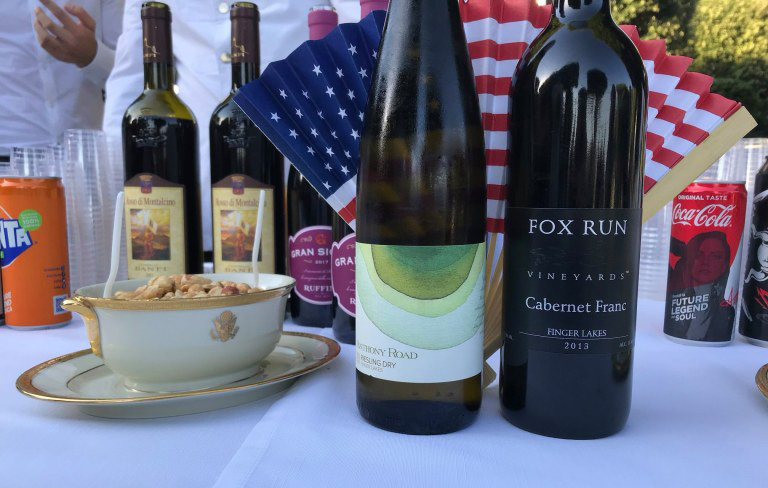After a talk with American importer and promoter of Finger Lakes’wines to Italy. In days when we are witnessing the war of wine import’s tarifs which can make the price of some European wines imported in the U.S. skyrocket in the next months, I was wondering how it works in the opposite way. American wineries don’t export much, especially to Europe, because it is difficult to compete with local wines’ low prices. U.S. wine exports, over 90% from California, reached $1.46 billion in winery revenues and 375 million liters (41.7 million cases) in 2018. Total exports were down 4.8% in value and 1.2% in volume. Less than 10 per cent of the total number of wineries in the U.S. sell wines abroad. Shipping overseas can be a risk and not an easy path, but if your target is an educated and curious consumer, Europe, and in this case Italy, can be an opportunity… Read why in this interview to Sally Semeria, Italian importer and distributor of American wines in Milan.
1. Why did you choose to import US wines to Italy in the first place?
Did I tell you my name? It is really Sally – like Sally Ride – the first American woman in space and because of this since I was a child I felt a connection with this country.
I started as a food & wine sales agent but I always wanted to work for a US company and I did for one of the most famous – Airbnb.
After this extraordinary job experience, I decided to try to mix them all: first step was resume my studies and become a certified Sommelier, and the second to focus on a wine region, know more about it, and see if their wines could be brought to Italy.
California, Oregon, Washington produce 90% of the US wine and their bottles are already known by Italian wine enthusiast: I decided to follow a different path, so I looked at the other 10% less known to find hidden gems.
Finger Lakes is the third US wine region for volumes, but it was the most interesting, for three reasons:
1. While sharing my ideas with the other sommeliers I learned that many of them stopped by chance in the region and found good wines – Finger Lakes is halfway between NYC and Niagara Falls, a very touristic route.
2. I noticed that in US wine magazines and websites, many Finger Lakes wines regularly reached high scores.
3. The most common product of the region – Riesling – is a wine I could easily compare with good benchmarks I could find here in Italy, so I could easily understand if the wines were good or not.
Then I planned my visit and started my tour: once there, in Finger Lakes I talked to many winemakers, oenologists and also geneticists. The wines I found have all a typical European feeling, like a well balanced sugar content and a moderate time in barrique. My guesses were right: these wines really have a potential in the Old World.
Finally, the pivotal moment of the tour: one of the last people I met in Finger Lakes worked with an importer focused on northern Europe markets. That meant I was able to have these bottles delivered to Europe.
My project was ready to start, a lot of paperwork and bureaucracy followed.
2. Italians usually tend to drink local or French, how do you promote American wines to your potential customers?
The wine market has many niches, for instance the table wine is the largest category in Italy because it is more available and economically accessible, for everyday consumption.
However, there is a growing public of wine enthusiasts, above all in large urban areas, who approaches differently the world of wine.
It is to this audience of curious and passionate that I refer to, an audience who is always looking for new products, travels and wants to discover new quality products.
At first it was a hard work of PR: I talked a lot about Finger Lakes on my social media profiles, but mostly with fellow Sommeliers I met in the Milan chapter of AIS – Associazione Italiana Sommelier, the association where I got my degree.
The experience of my husband Francesco Grandazzi in advertising and communication was really helpful to let me handle all the potential of digital communication.
Francesco talked to me about the “Judgment of Paris” – the wine competition of 1976 – and inspired by this event, blind tastings of Italian and US wines were the first activities I planned. Guessing which wine came from the US was hard and this fostered the credibility of my bottles.
From then on, PR, word of mouth, Social Media and influencer marketing are the tools helping me to promote Finger Lakes wines.
I don’t know if it’s because I was stubborn or only hyper passionate, but Finger Lakes wines were asked more and more for some private tastings and also official events in the AIS chapters: an unknown wine is a perfect way to test the skills of sommeliers, so my wines were perfect for the task.
3. Do you think that Millennials and young consumers are more open to taste wines from the New World? If so, why?
The younger generation looks for an experience, not only a simple wine tasting, and for them boundaries don’t matter.
What I can see in the youngest and better educated people attending the events, is that they want to distinguish themselves, share knowledge and discoveries for the pure love of it. Social media have a very important role in this.
Travelling is the greatest experience people want to share online, and Finger Lakes wine region is really accessible – just one hour of flight from NYC, the most popular destination for Italian tourists in the US.
That’s why I started collaborating with a US Travel Association in Italy to promote also wine tourism: it’s something different and unusual for Italians, but it’s working.
4. How about the pricing? Most of the American wineries do not export because they can’t compete with the local market, do you think that this is a misjudge or it is true?
The final cost of the product is not a problem if you can deliver the message of its uniqueness.
As I said before, it is all a question of target: the everyday consumer will never buy this kind of wines because he/she can’t understand the qualities and will turn on the national classics, but a more curious and prepared consumer will instead.
Importing this type of product can be undoubtedly expensive, not so much for the cost of the wine itself but for taxes and excise duties.
The first few times was anything but simple: bureaucracy can kill a project.
But I am tenacious, and in the end, becoming exclusive for Italy of numerous wineries, I managed to have reasonable costs and availability.
5. Why do you import only Finger Lakes’ wines? Do you think that Californian wines or Oregon’s ones could have a market too in Italy?
California and Oregon are already well known by Italian wine enthusiasts: Californians can be found sometimes even in large-scale retail trade and Oregon wines instead in wine shops, but with very high prices.
The overall quality of US wines is high and improving, but I think there is room to work on pricing and awareness.
What I wanted to do is trace a new path, and what I found in Finger Lakes is a good compromise, the outcome of a long study of “the other 10%” of US wine producers. I am looking at other interesting and less known wine regions to replicate the model.


